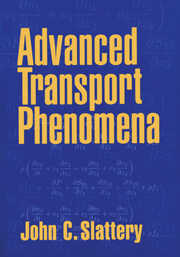Book contents
- Frontmatter
- Contents
- Preface
- List of Notation
- Advanced Transport Phenomena
- 1 Kinematics
- 2 Foundations for Momentum Transfer
- 3 Differential Balances in Momentum Transfer
- 4 Integral Averaging in Momentum Transfer
- 5 Foundations for Energy Transfer
- 6 Differential Balances in Energy Transfer
- 7 Integral Averaging in Energy Transfer
- 8 Foundations for Mass Transfer
- 9 Differential Balances in Mass Transfer
- 10 Integral Averaging in Mass Transfer
- A Tensor Analysis
- B More on the Transport Theorem
- References
- Author/Editor Index
- Index
8 - Foundations for Mass Transfer
Published online by Cambridge University Press: 05 June 2012
- Frontmatter
- Contents
- Preface
- List of Notation
- Advanced Transport Phenomena
- 1 Kinematics
- 2 Foundations for Momentum Transfer
- 3 Differential Balances in Momentum Transfer
- 4 Integral Averaging in Momentum Transfer
- 5 Foundations for Energy Transfer
- 6 Differential Balances in Energy Transfer
- 7 Integral Averaging in Energy Transfer
- 8 Foundations for Mass Transfer
- 9 Differential Balances in Mass Transfer
- 10 Integral Averaging in Mass Transfer
- A Tensor Analysis
- B More on the Transport Theorem
- References
- Author/Editor Index
- Index
Summary
This is an excellent time for review. In fact, a review is practically forced upon you in this chapter.
A body composed of a single species is a limiting case of multicomponent materials. In what follows, we reformulate the fundamental postulates made in Chapters 1, 2, and 5, to enable their application to multicomponent bodies. With a few relatively minor modifications, all we have said about single-component systems can be applied to multicomponent ones.
Viewpoint
Up to this point we have been primarily concerned with single-component materials or materials of uniform composition. Hereafter, we shall be treating a material consisting of N species or constituents that is undergoing an arbitrary number of homogeneous and heterogeneous chemical reactions. Not only are we interested in the velocity and temperature distributions in such a material, but we wish to follow its composition as a function of time and position. We may ask, for example, how rapidly a particular species formed by a catalytic reaction at an adjacent surface will distribute itself throughout a material; or we may wish to determine the rate at which a liquid droplet will evaporate into a surrounding gas stream.
Our first task is to choose a continuum model for an N -component material. We will wish to follow each species individually as the N-component mixture goes through some operation, possibly involving deformation, flow, and chemical reactions. We will view each species as a continuous medium with a variable mass-density field.
- Type
- Chapter
- Information
- Advanced Transport Phenomena , pp. 423 - 481Publisher: Cambridge University PressPrint publication year: 1999

